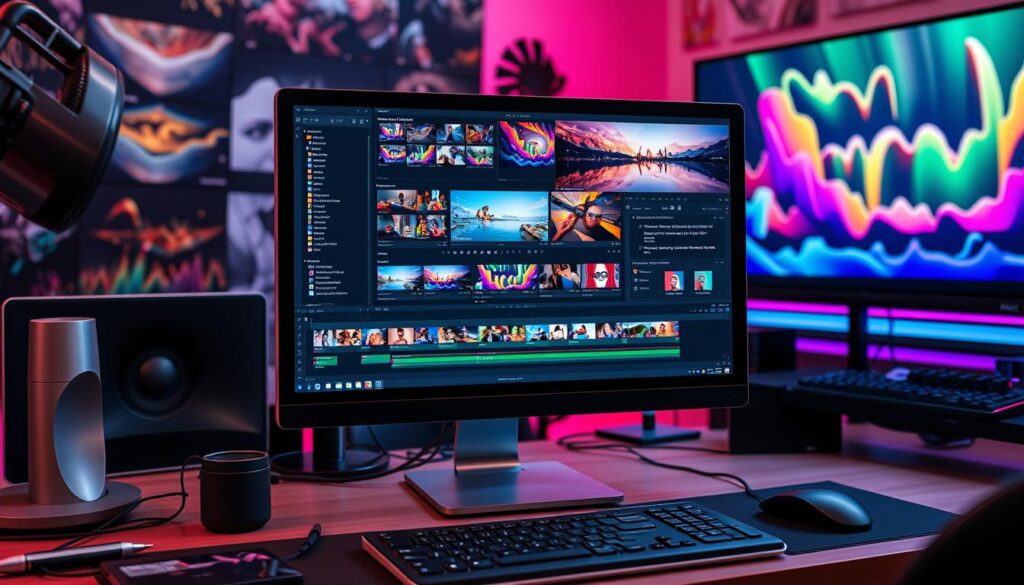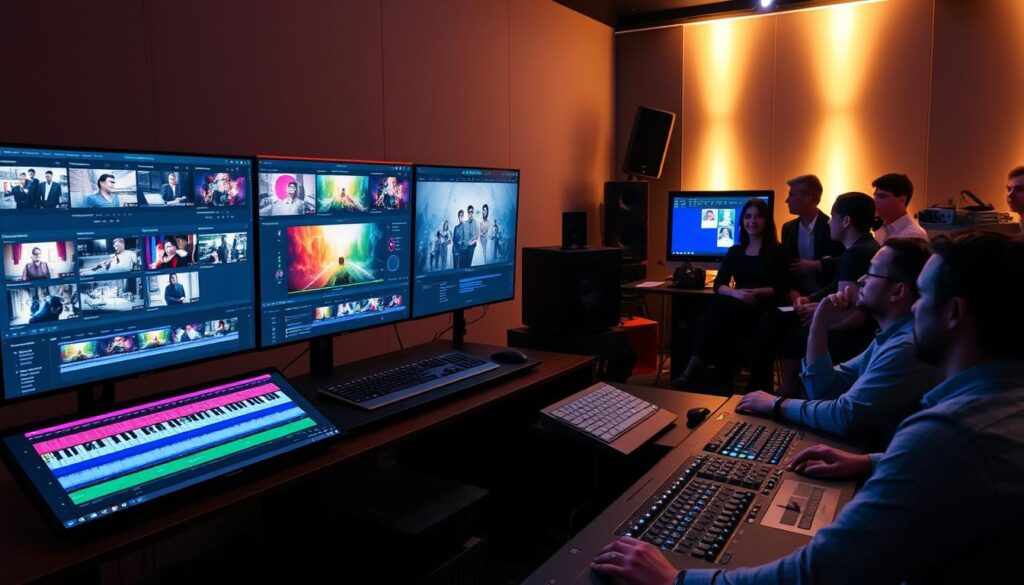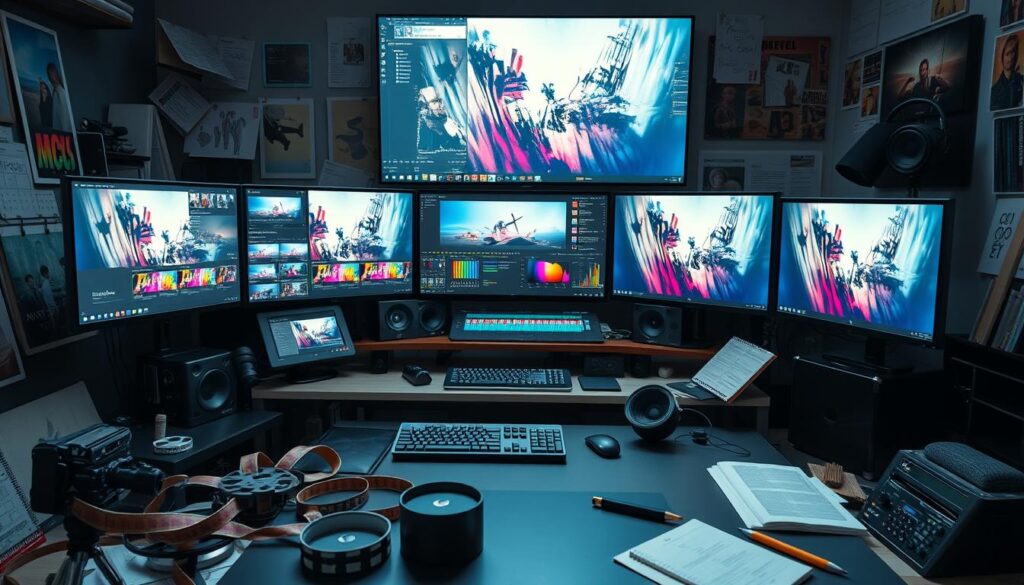In the world of multimedia, professional video editing is key. It can take your stories to new levels. This article will show you how to improve your videos, engage your audience, and make a strong impact.
Let’s start with the basics of video post-production. You’ll learn what makes your videos flow well. You’ll also discover how to use color grading, motion graphics, and visual effects. These skills will help you create stunning videos that connect with your viewers.
Key Takeaways
- Explore the core principles of professional video editing and post-production
- Discover the essential tools and software used by industry-leading video editors
- Learn techniques for enhancing visual storytelling through color grading and motion graphics
- Dive into the world of video compositing and visual effects for captivating multimedia projects
- Understand the importance of video mastering and collaborative workflows for video editing teams
Mastering the Art of Professional Video Editing
At the heart of great video content is professional video editing. This key part of video post-production brings a creator’s vision to life. It turns raw footage into a polished, engaging final product. Understanding non-linear editing and film editing techniques is vital for improving your video content.
Understanding the Fundamentals of Video Post-Production
Video post-production includes several important steps. These steps transform raw footage into a cohesive, visually striking final video. The main phases are:
- Video editing: Choosing, arranging, and refining shots for a smooth narrative flow.
- Color grading: Adjusting color, contrast, and look to achieve a specific aesthetic.
- Visual effects: Adding motion graphics, compositing, and special effects to enhance storytelling.
Learning these basic video post-production techniques is key to creating professional-grade video content. This content will captivate your audience.
Essential Tools and Software for Professional Video Editors
To improve your video editing skills, you need to know the top tools and software used by professionals. Some leading applications include:
- Non-linear editing software: Tools like Adobe Premiere Pro, Final Cut Pro, and DaVinci Resolve. They offer advanced features for editing, color grading, and visual effects.
- Motion graphics software: Apps like Adobe After Effects and Blackmagic Design Fusion. They help create dynamic title sequences, animations, and visual effects.
- Specialized plug-ins and extensions: Plugins for non-linear editing software. They add extra capabilities, such as VFX, color correction, and audio processing.
By learning to use these essential tools and software, you can enhance your video editing skills. This will help you deliver exceptional, polished video content.
“The art of editing is the soul of filmmaking.” – Walter Murch, acclaimed film editor
Enhancing Visual Storytelling with Color Grading
As professional video editors, we know how important color grading is. It makes our footage look better and supports the story we tell. This step in post-production helps us set the mood and tone of our videos.
Color grading changes the color, contrast, and brightness of your footage. It’s more than just fixing colors. It’s about making your video look the way you want it to. This can make people feel certain emotions and focus on what you want them to see.
Using color grading helps us tell our story better. We can pick colors that match the mood of our video. Whether it’s a dark film, a bright commercial, or a documentary, color grading brings our vision to life.
| Color Grading Techniques | Impact on Visual Storytelling |
|---|---|
| Desaturated, muted colors | Evoke a sense of melancholy, nostalgia, or gritty realism |
| Warm, vibrant tones | Convey a sense of energy, optimism, and excitement |
| Cool, blue-tinted hues | Create a sense of calmness, mystery, or suspense |
Learning to use color grading can make your videos stand out. It’s key for any project, from films to commercials. With color grading, you can bring your ideas to life in a way that grabs people’s attention.
Creating Captivating Motion Graphics
Motion graphics are key in professional video editing. They make your videos more engaging and memorable. From animated titles to smooth transitions, learning motion graphics is essential for video editors.
Techniques for Incorporating Motion Graphics in Video Projects
To add motion graphics to your videos, you need a careful plan. Use animated text for important info, data visualizations for stats, and transitions to guide the viewer. This way, you create a story that grabs your audience’s attention.
Popular Motion Graphics Software and Tools
- Adobe After Effects: A top choice for motion graphics and visual effects, with many tools for stunning animations.
- Blackmagic Design’s DaVinci Resolve: A video editing and color grading tool with a strong motion graphics module.
- Maxon Cinema 4D: Great for creating detailed, high-quality motion graphics and visual effects.
- Blender: A free, open-source 3D creation suite for motion graphics, video compositing, and visual effects.
Learning these software and tools lets you bring your creative ideas to life. Your video projects will become engaging and memorable for your viewers.
Professional Video Editing: Elevating Your Content with Visual Effects
In video post-production, video compositing and visual effects can take your content to new levels. By blending different elements, you can make scenes that grab your audience’s attention. These scenes leave a lasting impression.
Introduction to Video Compositing and Visual Effects
Video compositing mixes various video and image elements into one scene. This method lets you add green-screen footage, 3D graphics, and more. It turns raw footage into a polished, movie-like masterpiece.
Visual effects add to your video’s appeal. They include realistic effects like explosions and dynamic camera moves. They also include stunning color grading and particle effects. The right effects can make your story come alive.
Advanced Visual Effects Techniques for Video Professionals
- Mastering video compositing for seamless blend of multiple elements
- Exploring advanced visual effects techniques, such as:
- Photorealistic 3D graphics integration
- Dynamic camera movements and stabilization
- Realistic particle effects and simulations
- Sophisticated color grading and color correction
- Utilizing cutting-edge video post-production software and tools for maximum impact
With video compositing and visual effects, you can turn raw footage into something amazing. These advanced techniques are key for professional video editors. They help create captivating content that grabs the audience’s attention.

“The art of video compositing and visual effects is not just about technical proficiency, but about the ability to tell a story that resonates with the viewer. It’s a powerful tool in the hands of a skilled video editor.”
Video Mastering: Polishing Your Final Product
The final stage of professional video editing is video mastering. It’s key to making sure your final product looks great and is ready to share. This process improves video quality and manages file size, making your video better for viewers.
Optimizing Video Quality and Compression
Mastering pros use many techniques to boost video quality. They adjust color, reduce noise, and sharpen images. These steps make your video look amazing and grab viewers’ attention.
Compression is also vital in video mastering. It lets you keep video quality high while making files smaller. By picking the right codec and bitrate, your video works well on different devices and platforms.
| Compression Technique | Benefit |
|---|---|
| H.264 Codec | Offers excellent quality at smaller file sizes, ideal for web and mobile platforms |
| Variable Bitrate (VBR) | Adjusts the bitrate dynamically, preserving quality in complex scenes while reducing file size in simpler ones |
| Adaptive Bitrate Streaming | Automatically adjusts the bitrate to match the viewer’s internet connection, providing a seamless playback experience |
By mastering your video with these methods, you make it look great and work well on many devices. This enhances the editing experience for your audience.
Collaborative Workflows for Video Editing Teams
In the world of video editing, teamwork is crucial. A team of experts, like editors and visual effects artists, work together to create a project. Learning how to work together well is key to better communication and project management.
Good teamwork starts with clear communication. Video editing teams use project management tools to share tasks and files. Regular meetings, both in person and online, help everyone stay in sync and solve problems quickly.
Having a central place for all assets is also important. A cloud-based library for media and resources helps team members access what they need easily. This saves time and ensures the project looks consistent.
| Collaborative Workflow Strategies | Benefits |
|---|---|
| Project management tools | Streamlined task assignment, status updates, and file sharing |
| Centralized asset library | Efficient access to media files, templates, and resources |
| Regular team meetings | Effective communication and problem-solving |
By using these teamwork strategies, video editing teams can improve their work. This leads to a smoother and more efficient production process. The end result is a better video.

“Collaboration is the essence of great work in the field of video editing. By working together, we can achieve more than we ever could alone.”
Exploring Non-Linear Editing Software
In the world of video post-production, non-linear editing software is key. It lets editors easily work with video, audio, and graphics. This gives them great control and flexibility in their work.
Industry-Standard Non-Linear Editing Tools
There are a few top non-linear editing tools in the industry. Each has its own special features. Here are some of the most used ones:
- Adobe Premiere Pro – A full-featured, cross-platform editing solution that works well with other Adobe apps.
- Final Cut Pro – Apple’s top editing software, known for its easy-to-use interface and strong editing tools.
- DaVinci Resolve – A versatile editing platform that also shines in color grading, visual effects, and audio.
- Avid Media Composer – A leading non-linear editing suite used in film, TV, and broadcast.
Choosing the Right Software for Your Video Editing Needs
Picking the right non-linear editing software is important. It affects your workflow and the quality of your work. Think about these things when choosing:
- How complex your projects are
- If it fits with your current systems and processes
- How easy it is to learn and use
- If it has the features and tools you need
- If it works well with other video post-production software
- The cost and what you get for it
By looking at your needs and what each software offers, you can choose wisely. This will make your video post-production work easier and help you reach your creative goals.
“Non-linear editing has changed film editing, letting us try new things and tell stories in new ways.”
Multimedia Editing: Integrating Video, Audio, and Graphics
In the world of professional video editing, mixing different media is key. Learning to blend video, audio, and graphics can make your work stand out. Find out how to create engaging and unified multimedia experiences for your audience.
Matching audio with your video is a must in multimedia editing. Learn how to keep your audio and visuals in perfect sync. This boosts your production’s quality. Add graphics like titles and animations to make your story more engaging and visually appealing.
By working well with different media, you can make your final product engaging and polished. Explore video compositing and visual effects to add depth to your work. Improve your multimedia editing skills and wow your viewers with a great mix of video, audio, and graphics.



